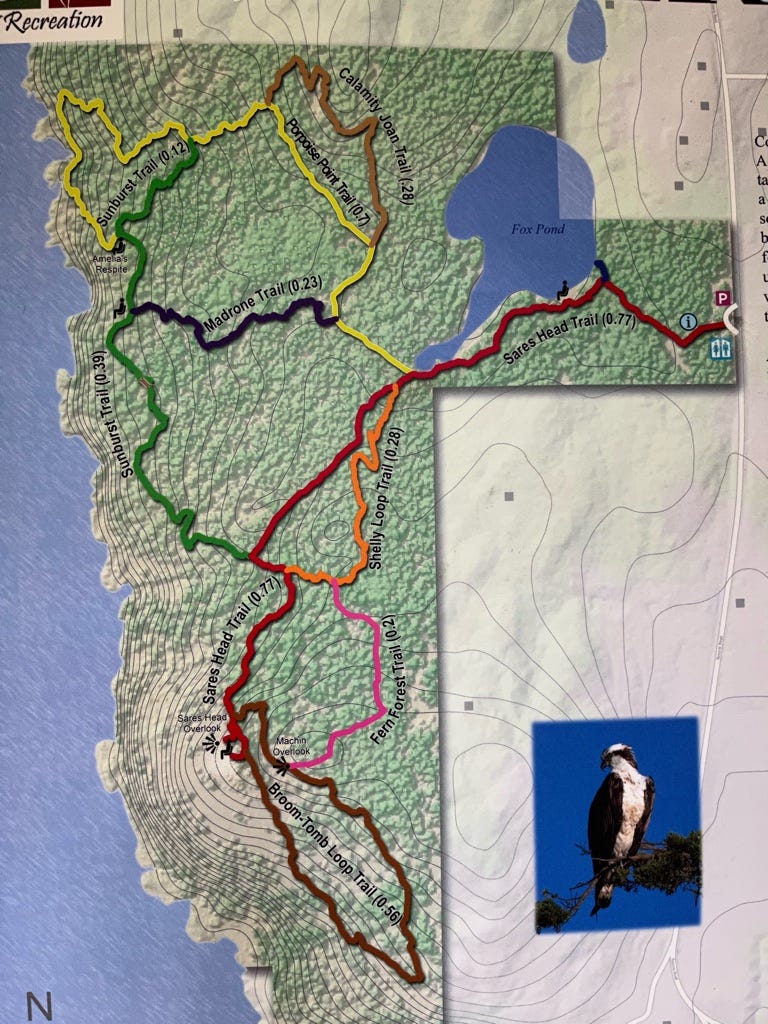Loop Trail or Back-and-Forth - a way to think of story-structure
Reflections on hiking and writing. Aren't you glad it's Fall? Hiking is over for the year...

Didn’t see this guy on your way in… or out?
You might be tiring of my hiking analogies. This is the last… until next season.
But I did promise a post on the “loop trail” versus the “back and forth,” and the idea struck me as I was on Whidbey Island, WA, in a park full of paths, and our plan was to stick to the outer-most and go in a great circle, not doubling back at any point.
Then we found ourselves talking about what it is to return on a path already taken hours or even days before, and see anew, all that was missed when coming from the other direction. I began to mull over the diagramming of stories… drawing the shapes and paths of telling. And what those lines might mean to the story.
A loop trail—as you’ve picked up—goes in a “circle,” returning to the starting place. Of course, a trail could start one place and end in another. But if you’ve driven a vehicle to get there, at some point you’ll need to reconnect with that vehicle.
(Though is we’re thinking metaphor/story-analogy, pause to consider the difference…)
A back-and-forth trail will take you to a place to pitch a tent (possibly!) and then you’ll pack up and return the way you came.
What do you prefer? Even if you don’t hike—if you’re a walker or a roller—you can imagine. And do you see this in any way as being analogous with life?
As a writer, I find it almost impossible to navigate life without thinking in terms of being a writer. I struggle to grasp how non-writers manage it, truly. (Though I must, because not all of my characters are writers. And I have lived life doing other things to provide food and shelter.) Writing provides me with a lens for life, and I feel that life itself is more of a loop trail than anything. But writing allows me to double-back, and take a look around.
What do the stories we write do? This is useful to think about, maybe especially if you’re at a point of trying to see a longer work holistically… is that novel moving along in a linear way? Or is it a loop? What does it mean to have to return to the beginning in some way?
In his book on the art of writing and creating picturebooks, Uri Shulevitz says that “the end remembers the beginning,” and this is not only true of picturebooks but of all works, to my mind, including nonfiction essays, poems, chapters, short stories, novels. This is always some bit of checkpoint for me, at the close of a first draft: does the end of the work remember the beginning? (And so often, some flitting foreshadow is in the introductory words of a work: pick up a number of books you are familiar with and look at the opening. See? You lose this, if you don’t read a book more than once. Or at least, flip back to look once you’ve read through.)
You may have completed a “linear” project, and feel it’s missing something; this might be what it’s missing. Often in structure, if we look at our natural “real” world—lives as lived—it will supply some answer to story structure. We think we are imposing “structure” on story, but structure is a natural thing. We return from whence we came. Order-chaos-order. Home-away-home. Even as the “order” or “home” is changed. And structures other than this model are based in some natural thing—if you think about it long enough.
The thing about a loop trail is that you are always experiencing “new.” You round a corner, and there is it—something you’ve not seen before. Then another corner, and another. It’s all a bit of a rush! Then back to your car.
On a back-and-forth trail, the strangest piece—for me—is that I have been here before, but it can look unrecognizable. I have learned to take photos of things I see that catch me on the “way in,” because on the way “out,” I’ll miss them. I’m seeing from 180 degrees, from the back as it were. That tree I saw, with certain mosses, with a branch like a human arm, I’ll never see again. Now I’m seeing a dancing tree. Two photographs there.
On a hike in Manning Park, we were looking for the perfect spot to pitch the tent. We found it. And on the way, we passed a most ordinary-looking area to our right on the way in, and thought nothing of it. But on the way back, we spotted a rise of land behind trees we’d passed earlier, and climbed off trail to find a breath-taking spot surrounded 360 degrees with mountains; a spot perfect for star-gazing. We’d missed it completely. On a loop trail, we would never have made this discovery. (And consider: we had to make an effort, and walk up to suss it out.)
What happens if you turn around, and revisit your story? If you walk back “out” through it? What are you going to see?
Without conscious thought, we can’t do this in our real world (and ONLY in thought can we do this in life!) But in your stories, you can.
How might this change your approach to writing, and story-telling?
~~~
Diagramming your story-structure
I mention it in my post about an alternative to Freytag’s Pyramid:
In Jack Hodgins’ book on writing, A Passion for Narrative, he writes of the “shapes of stories,” and draws some possibilities.
Forget that triangle of “rising action,” “climax,” “resolution.”
Let’s think and see anew.
Take a look at each. Study each. Let your mind rove, and reach to story fragments—then let the fragments grow.
The spiral-ly shape… does “history repeat itself”? Can this happen within a story? What if each recursive loop is smaller or larger—more expansive—in size?
That line with the tear-drops hanging from it—what might that be? A story told in flashbacks, growing with import? What’s the “tear-drop” that’s reaching up? A foreshadowing?
What’s with the square with a triangle in the corner? A story told in four scenes, (four seasons? four meals? four meeting with different people? four fill-in-the-blanks?) in which the main character is caught in the end, in an emotional room-with-no-door…?
Or something completely different?
What is the shape of the story you are currently working with? Can you draw it out? If it’s not working currently, might you need to draw something different this time? Maybe draw a number of possibilities—one of which will point you in a renewed direction.
Here’s the Whidbey Island trail map—for your possibilities.





I'm using a way overly ambitious story structure -- a ring cycle -- for my novel, so the book goes in towards the center (climax of story) and comes out again. So, probably more similar to a back-and-forth trail than a loop trail? The opening is the starting point that will be circled back to at the end. It needs to not only set the scene and introduce main characters, but also foreshadow the coming crisis, and hint at the problems lying beneath. A daunting prospect; I think I'd rather go camping. And I hate camping! ;)
I have discovered that the book I am writing seems to have 2 parts. So I am imagining that during the first part I was climbing up a small hill, with the hook at each end of the chapter a small peak, where you can see the next hill in front of you as if I was traversing a series of foothills. For each start of the next chapter is a slight dip (valley) then rising to the top of the next hill, so by the climax at the end of part 1, I was at the a considerably higher spot than I started with. Now with the pyramid structure this would be the top, but when I got there, what I found is that I dropped down into a fairly deep valley, and started the trip up another foot hill, leading to another peak. Only I am at a higher place than I started the book. But, the pacing, of going up slowly, looking around (back from where I came) and foward to where I need to go, is starting out slowly again. What I assume is that the book's climax will come when I make it to the top of a second, but higher mountain. What I am struck by is that most of my mysteries are more of a loop...where after the climax (mystery solved) I end up with a fairly long epilog, where I revisit where I started (but maybe not loop, but a quick trip back, seeing all the clues from the new perspective of the solved mystery, then with some sense of how the trip has changed my main protagonist. As usual, thanks for the prompt to think about the work from a new perspective.